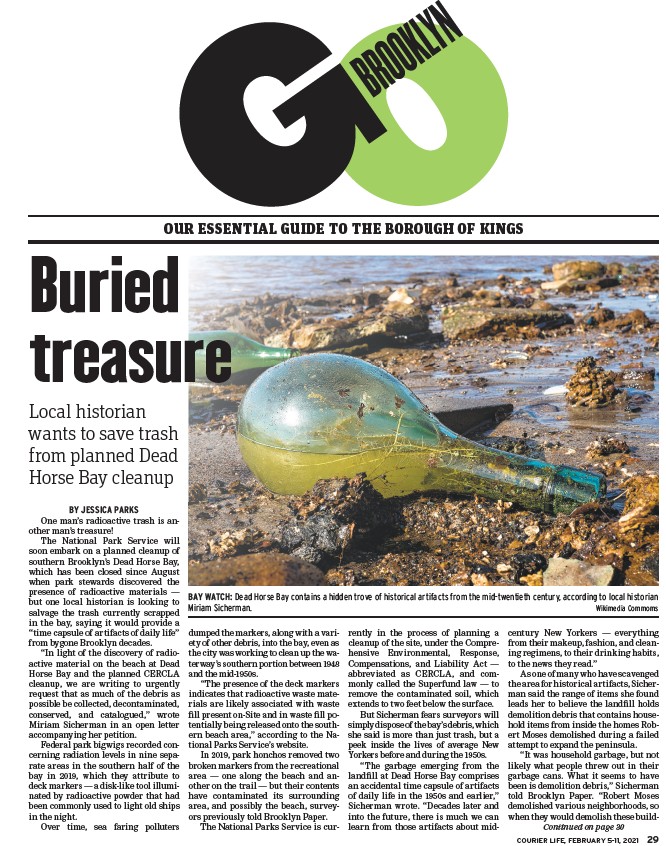
OUR ESSENTIAL GUIDE TO THE BOROUGH OF KINGS
COURIER LIFE, FEBRUARY 5-11, 2021 29
BY JESSICA PARKS
One man’s radioactive trash is another
man’s treasure!
The National Park Service will
soon embark on a planned cleanup of
southern Brooklyn’s Dead Horse Bay,
which has been closed since August
when park stewards discovered the
presence of radioactive materials —
but one local historian is looking to
salvage the trash currently scrapped
in the bay, saying it would provide a
“time capsule of artifacts of daily life”
from bygone Brooklyn decades.
“In light of the discovery of radioactive
material on the beach at Dead
Horse Bay and the planned CERCLA
cleanup, we are writing to urgently
request that as much of the debris as
possible be collected, decontaminated,
conserved, and catalogued,” wrote
Miriam Sicherman in an open letter
accompanying her petition.
Federal park bigwigs recorded concerning
radiation levels in nine separate
areas in the southern half of the
bay in 2019, which they attribute to
deck markers — a disk-like tool illuminated
by radioactive powder that had
been commonly used to light old ships
in the night.
Over time, sea faring polluters
dumped the markers, along with a variety
of other debris, into the bay, even as
the city was working to clean up the waterway’s
southern portion between 1948
and the mid-1950s.
“The presence of the deck markers
indicates that radioactive waste materials
are likely associated with waste
fi ll present on-Site and in waste fi ll potentially
being released onto the southern
beach area,” according to the National
Parks Service’s website.
In 2019, park honchos removed two
broken markers from the recreational
area — one along the beach and another
on the trail — but their contents
have contaminated its surrounding
area, and possibly the beach, surveyors
previously told Brooklyn Paper.
The National Parks Service is currently
in the process of planning a
cleanup of the site, under the Comprehensive
Environmental, Response,
Compensations, and Liability Act —
abbreviated as CERCLA, and commonly
called the Superfund law — to
remove the contaminated soil, which
extends to two feet below the surface.
But Sicherman fears surveyors will
simply dispose of the bay’s debris, which
she said is more than just trash, but a
peek inside the lives of average New
Yorkers before and during the 1950s.
“The garbage emerging from the
landfi ll at Dead Horse Bay comprises
an accidental time capsule of artifacts
of daily life in the 1950s and earlier,”
Sicherman wrote. “Decades later and
into the future, there is much we can
learn from those artifacts about midcentury
New Yorkers — everything
from their makeup, fashion, and cleaning
regimens, to their drinking habits,
to the news they read.”
As one of many who have scavenged
the area for historical artifacts, Sicherman
said the range of items she found
leads her to believe the landfi ll holds
demolition debris that contains household
items from inside the homes Robert
Moses demolished during a failed
attempt to expand the peninsula.
“It was household garbage, but not
likely what people threw out in their
garbage cans. What it seems to have
been is demolition debris,” Sicherman
told Brooklyn Paper. “Robert Moses
demolished various neighborhoods, so
when they would demolish these build-
Buried
treasure
Local historian
wants to save trash
from planned Dead
Horse Bay cleanup
BAY WATCH: Dead Horse Bay contains a hidden trove of historical artifacts from the mid-twentieth century, according to local historian
Miriam Sicherman. Wikimedia Commoms
Continued on page 30